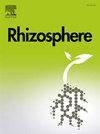Physicochemical properties and fungal communities of forest soil combine to influence ginseng rusty root grade
IF 3.4
3区 生物学
Q1 PLANT SCIENCES
引用次数: 0
Abstract
Ginseng rusty root (GRR) disease is a common ginseng disease that affects the quality and value of ginseng. Although some studies have focused on the mechanism of GRR incidence in farmland, little is known in forest conditions. The objective of this study was to clarify how GRR grades correlate with the physicochemical properties and fungi in forest soils. After examination of 38 sites in Changbai Mountain Range, 8 sites were selected for sampling, guided by their GRR gradings. The soil properties of forest soil samples were analyzed, and ITS-1 sequencing of the rhizosphere fungi was performed. The sequencing results were subjected to multivariate statistical analysis to explore GRR indicators. The results showed that soil pH, total nitrogen, total phosphorus, soil organic carbon, and moisture content varied significantly among 8 sampling sites. Total phosphorus and soil organic carbon were positively correlated with GRR grade. High GRR grade soils showed extremely high moisture content and low pH. At the phylum level, the abundances of Mortierellomycota, Rozellomycota, and Ascomycota were higher in high GRR grade soils. At the species level, Roesleria subterranea and Ilyonectria mors-panacis were abundant in high GRR grade soils. Overall, the grade of GRR is influenced by a combination of soil properties and the fungal community present in the soil. This study suggests that soil physicochemical properties and certain Ilyonectria spp. can be used as indicators for GRR grade. These scientific information will aid in selecting forest fields for ginseng planting.

求助全文
约1分钟内获得全文
求助全文
来源期刊

Rhizosphere
Agricultural and Biological Sciences-Agronomy and Crop Science
CiteScore
5.70
自引率
8.10%
发文量
155
审稿时长
29 days
期刊介绍:
Rhizosphere aims to advance the frontier of our understanding of plant-soil interactions. Rhizosphere is a multidisciplinary journal that publishes research on the interactions between plant roots, soil organisms, nutrients, and water. Except carbon fixation by photosynthesis, plants obtain all other elements primarily from soil through roots.
We are beginning to understand how communications at the rhizosphere, with soil organisms and other plant species, affect root exudates and nutrient uptake. This rapidly evolving subject utilizes molecular biology and genomic tools, food web or community structure manipulations, high performance liquid chromatography, isotopic analysis, diverse spectroscopic analytics, tomography and other microscopy, complex statistical and modeling tools.
 求助内容:
求助内容: 应助结果提醒方式:
应助结果提醒方式:


